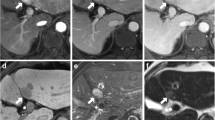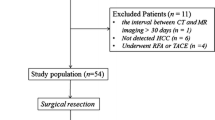Abstract
Background
We aimed to evaluate gadolinium ethoxybenzyl diethylenetriamine pentaacetic acid (Gd-EOB-DTPA)-enhanced magnetic resonance imaging (MRI) for the detection of hepatocellular carcinomas (HCCs) and dysplastic nodules (DNs) compared with dynamic multi-detector row computed tomography (MDCT), and to discriminate between HCCs and DNs.
Methods
Eighty-six nodules diagnosed as HCC or DNs were retrospectively investigated. Gd-EOB-DTPA-enhanced MRI and dynamic MDCT were compared with respect to their diagnostic ability for hypervascular HCCs and detection sensitivity for hypovascular tumors. The ability of hepatobiliary images of Gd-EOB-DTPA-enhanced MRI to discriminate between these nodules was assessed. We also calculated the EOB enhancement ratio of the tumors.
Results
For hypervascular HCCs, the diagnostic ability of Gd-EOB-DTPA-enhanced MRI was significantly higher than that of MDCT for tumors less than 2 cm (p = 0.048). There was no difference in the detection of hypervascular HCCs between hepatobiliary phase images of Gd-EOB-DTPA-enhanced MRI (43/45: 96%) and dynamic MDCT (40/45: 89%), whereas the detection sensitivity of hypovascular tumors by Gd-EOB-DTPA-enhanced MRI was significantly higher than that by dynamic MDCT (39/41: 95% vs. 25/41: 61%, p = 0.001). EOB enhancement ratios were decreased in parallel with the degree of differentiation in DNs and HCCs, although there was no difference between DNs and hypovascular well-differentiated HCCs.
Conclusion
The diagnostic ability of Gd-EOB-DTPA-enhanced MRI for hypervascular HCCs less than 2 cm was significantly higher than that of MDCT. For hypovascular tumors, the detection sensitivity of hepatobiliary phase images of Gd-EOB-DTPA-enhanced MRI was significantly higher than that of dynamic Gd-EOB-DTPA-enhanced MRI and dynamic MDCT. It was difficult to distinguish between DNs and hypovascular well-differentiated HCCs based on the EOB enhancement ratio.





Similar content being viewed by others
References
Krinsky G. Imaging of dysplastic nodules and small hepatocellular carcinomas: experience with explanted livers. Intervirology. 2004;47:191–8.
Kudo M. Imaging diagnosis of hepatocellular carcinoma and premalignant/borderline lesions. Semin Liver Dis. 1999;19:297–309.
Matsui O, Kadoya M, Kameyama T, Yoshikawa J, Takashima T, Nakanuma Y, et al. Benign and malignant nodules in cirrhotic livers: distinction based on blood supply. Radiology. 1991;178:493–7.
Takayasu K, Muramatsu Y, Furukawa H, Wakao F, Moriyama N, Takayama T, et al. Early hepatocellular carcinoma: appearance at CT during arterial portography and CT arteriography with pathologic correlation. Radiology. 1995;194:101–5.
Asahina Y, Izumi N, Uchihara M, Noguchi O, Ueda K, Inoue K, et al. Assessment of Kupffer cells by ferumoxides-enhanced MR imaging is beneficial for diagnosis of hepatocellular carcinoma: comparison of pathological diagnosis and perfusion patterns assessed by CT hepatic arteriography and CT arterioportography. Hepatol Res. 2003;27:196–204.
Imai Y, Murakami T, Yoshida S, Nishikawa M, Ohsawa M, Tokunaga K, et al. Superparamagnetic iron oxide-enhanced magnetic resonance images of hepatocellular carcinoma: correlation with histological grading. Hepatology. 2000;32:205–12.
Inoue T, Kudo M, Watai R, Pei Z, Kawasaki T, Minami Y, et al. Differential diagnosis of nodular lesions in cirrhotic liver by post-vascular phase contrast-enhanced US with Levovist: comparison with superparamagnetic iron oxide magnetic resonance images. J Gastroenterol. 2005;40:1139–47.
Hamm B, Staks T, Mühler A, Bollow M, Taupitz M, Frenzel T, et al. Phase I clinical evaluation of Gd-EOB-DTPA as a hepatobiliary MR contrast agent: safety, pharmacokinetics, and MR imaging. Radiology. 1995;195:785–92.
Halavaara J, Breuer J, Ayuso C, Balzer T, Bellin MF, Blomqvist L, et al. Liver tumor characterization: comparison between liver-specific gadoxetic acid disodium-enhanced MRI and biphasic CT—a multicenter trial. J Comput Assist Tomogr. 2006;30:345–54.
Kogita S, Imai Y, Okada M, Kim T, Onishi H, Takamura M, et al. Gd-EOB-DTPA-enhanced magnetic resonance images of hepatocellular carcinoma: correlation with histological grading and portal blood flow. Eur Radiol. 2010;20:2405–13.
[No authors listed]. Terminology of nodular hepatocellular lesions. International Working Party. Hepatology. 1995;22:983–993.
The International Consensus Group for Hepatocellular Neoplasia. Pathologic diagnosis of early hepatocellular carcinoma: a report of the International Consensus Group for Hepatocellular Neoplasia. Hepatology. 2009;49:658–64.
Sakamoto M, Mori T, Masugi Y, Effendi K, Rie I, Du W. Candidate molecular markers for histological diagnosis of early hepatocellular carcinoma. Intervirology. 2008;51(Suppl 1):42–5.
Di Tommaso L, Franchi G, Park YN, Fiamengo B, Destro A, Morenghi E, et al. Diagnostic value of HSP70, glypican 3, and glutamine synthetase in hepatocellular nodules in cirrhosis. Hepatology. 2007;45:725–34.
Kim YK, Kim CS, Han YM, Kwak HS, Jin GY, Hwang SB, et al. Detection of hepatocellular carcinoma: gadoxetic acid-enhanced 3-dimensional magnetic resonance imaging versus multi- detector row computed tomography. J Comput Assist Tomogr. 2009;33:844–50.
Kim SH, Kim SH, Lee J, Kim MJ, Jeon YH, Park Y, et al. Gadoxetic acid-enhanced MRI versus triple-phase MDCT for the preoperative detection of hepatocellular carcinoma. AJR Am J Roentgenol. 2009;192:1675–81.
Akai H, Kiryu S, Matsuda I, Satou J, Takao H, Tajima T, et al. Detection of hepatocellular carcinoma by Gd-EOB-DTPA-enhanced liver MRI: comparison with triple phase 64 detector row helical CT. Eur J Radiol. 2011;80:310–5.
Di Martino M, Marin D, Guerrisi A, Baski M, Galati F, Rossi M, et al. Intraindividual comparison of gadoxetate disodium-enhanced MR Imaging and 64-Section multidetector CT in the detection of hepatocellular carcinoma in patients with cirrhosis. Radiology. 2010;256:806–16.
Ahn SS, Kim MJ, Lim JS, Hong HS, Chung YE, Choi JY. Added value of gadoxetic acid-enhanced hepatobiliary phase MR imaging in the diagnosis of hepatocellular carcinoma. Radiology. 2010;255:459–66.
Hayashi M, Matsui O, Ueda K, Kawamori Y, Gabata T, Kadoya M. Progression to hypervascular hepatocellular carcinoma: correlation with intranodular blood supply evaluated with CT during intraarterial injection of contrast material. Radiology. 2002;225:143–9.
Kudo M, Japan Society of Hepatology. Management of hepatocellular carcinoma in Japan: consensus-based clinical practice manual proposed by the Japan Society of Hepatology. Oncology. 2007;72(suppl 1):2–15.
Tajima T, Honda H, Taguchi K, Asayama Y, Kuroiwa T, Yoshimitsu K, et al. Sequential hemodynamic change in hepatocellular carcinoma and dysplastic nodules: CT angiography and pathologic correlation. AJR Am J Roentgenol. 2002;178:885–97.
Kudo M. Multistep human hepatocarcinogenesis: correlation of imaging with pathology. 27. J Gastroenterol. 2009;44(Suppl 19):112–8.
Conflict of interest
The authors declare that they have no conflict of interest.
Author information
Authors and Affiliations
Corresponding author
Rights and permissions
About this article
Cite this article
Inoue, T., Kudo, M., Komuta, M. et al. Assessment of Gd-EOB-DTPA-enhanced MRI for HCC and dysplastic nodules and comparison of detection sensitivity versus MDCT. J Gastroenterol 47, 1036–1047 (2012). https://doi.org/10.1007/s00535-012-0571-6
Received:
Accepted:
Published:
Issue Date:
DOI: https://doi.org/10.1007/s00535-012-0571-6




